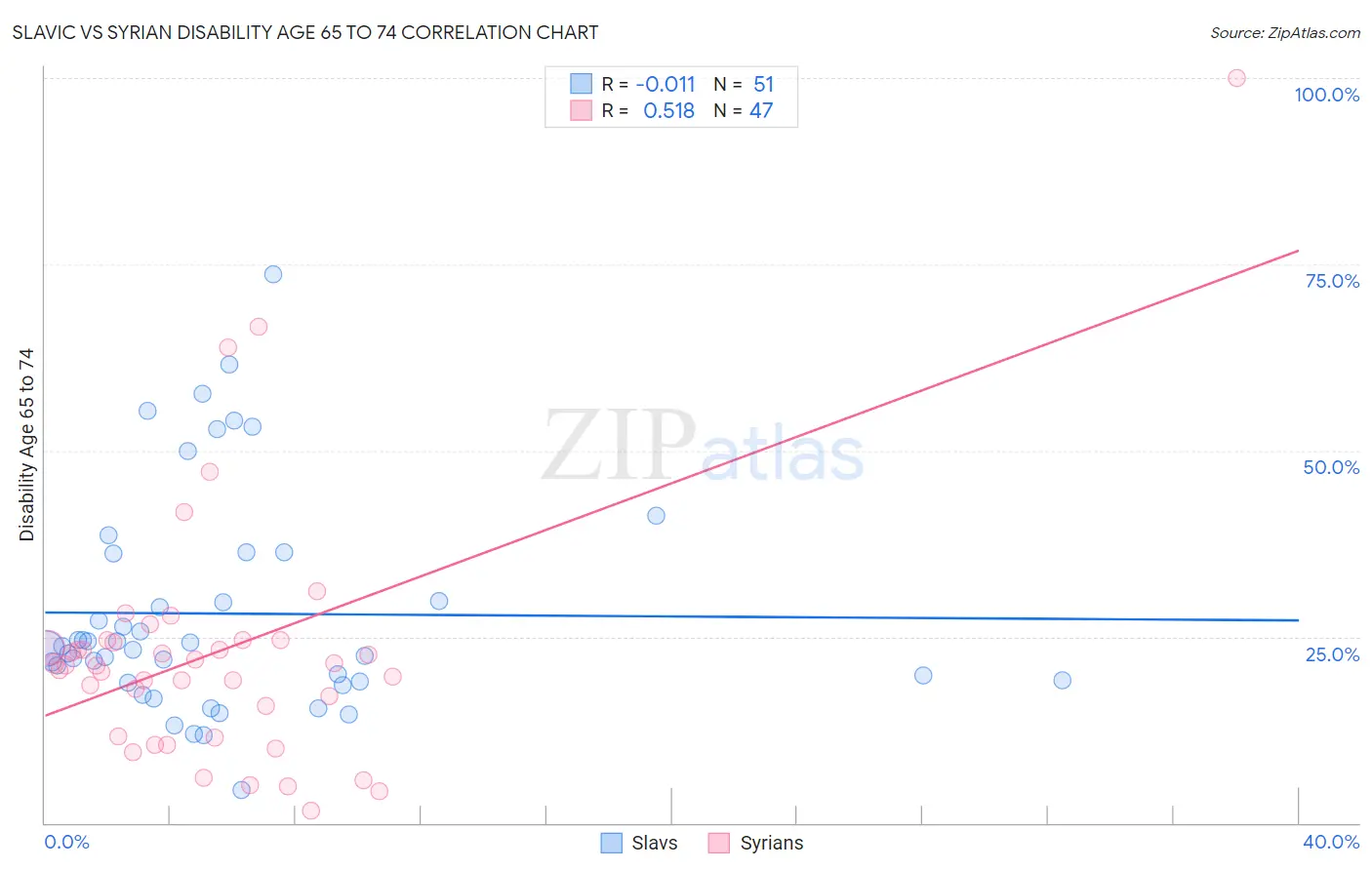Slavic vs Syrian Disability Age 65 to 74
COMPARE
Slavic
Syrian
Disability Age 65 to 74
Disability Age 65 to 74 Comparison
Slavs
Syrians
23.0%
DISABILITY AGE 65 TO 74
75.2/ 100
METRIC RATING
153rd/ 347
METRIC RANK
22.3%
DISABILITY AGE 65 TO 74
95.3/ 100
METRIC RATING
113th/ 347
METRIC RANK
Slavic vs Syrian Disability Age 65 to 74 Correlation Chart
The statistical analysis conducted on geographies consisting of 270,690,896 people shows no correlation between the proportion of Slavs and percentage of population with a disability between the ages 65 and 75 in the United States with a correlation coefficient (R) of -0.011 and weighted average of 23.0%. Similarly, the statistical analysis conducted on geographies consisting of 266,020,222 people shows a substantial positive correlation between the proportion of Syrians and percentage of population with a disability between the ages 65 and 75 in the United States with a correlation coefficient (R) of 0.518 and weighted average of 22.3%, a difference of 2.9%.

Disability Age 65 to 74 Correlation Summary
| Measurement | Slavic | Syrian |
| Minimum | 4.4% | 1.7% |
| Maximum | 73.7% | 100.0% |
| Range | 69.2% | 98.3% |
| Mean | 28.1% | 22.9% |
| Median | 23.4% | 21.2% |
| Interquartile 25% (IQ1) | 19.0% | 11.7% |
| Interquartile 75% (IQ3) | 36.1% | 24.5% |
| Interquartile Range (IQR) | 17.1% | 12.8% |
| Standard Deviation (Sample) | 14.7% | 17.3% |
| Standard Deviation (Population) | 14.6% | 17.1% |
Similar Demographics by Disability Age 65 to 74
Demographics Similar to Slavs by Disability Age 65 to 74
In terms of disability age 65 to 74, the demographic groups most similar to Slavs are Sri Lankan (23.0%, a difference of 0.090%), British (23.0%, a difference of 0.10%), Immigrants from Western Asia (23.0%, a difference of 0.10%), Finnish (22.9%, a difference of 0.11%), and Canadian (22.9%, a difference of 0.20%).
| Demographics | Rating | Rank | Disability Age 65 to 74 |
| Alsatians | 83.7 /100 | #146 | Excellent 22.8% |
| Immigrants | Uzbekistan | 83.1 /100 | #147 | Excellent 22.8% |
| New Zealanders | 79.9 /100 | #148 | Good 22.9% |
| Swiss | 79.7 /100 | #149 | Good 22.9% |
| Canadians | 77.7 /100 | #150 | Good 22.9% |
| Immigrants | Morocco | 77.6 /100 | #151 | Good 22.9% |
| Finns | 76.5 /100 | #152 | Good 22.9% |
| Slavs | 75.2 /100 | #153 | Good 23.0% |
| Sri Lankans | 74.0 /100 | #154 | Good 23.0% |
| British | 73.9 /100 | #155 | Good 23.0% |
| Immigrants | Western Asia | 73.8 /100 | #156 | Good 23.0% |
| Czechoslovakians | 72.4 /100 | #157 | Good 23.0% |
| Immigrants | Vietnam | 69.1 /100 | #158 | Good 23.1% |
| South American Indians | 65.5 /100 | #159 | Good 23.1% |
| Koreans | 64.2 /100 | #160 | Good 23.1% |
Demographics Similar to Syrians by Disability Age 65 to 74
In terms of disability age 65 to 74, the demographic groups most similar to Syrians are Immigrants from South America (22.3%, a difference of 0.050%), Ukrainian (22.3%, a difference of 0.080%), Serbian (22.3%, a difference of 0.11%), Immigrants from Peru (22.3%, a difference of 0.13%), and Laotian (22.3%, a difference of 0.15%).
| Demographics | Rating | Rank | Disability Age 65 to 74 |
| Peruvians | 96.1 /100 | #106 | Exceptional 22.2% |
| Slovenes | 96.1 /100 | #107 | Exceptional 22.2% |
| Immigrants | Zimbabwe | 96.1 /100 | #108 | Exceptional 22.3% |
| Albanians | 95.8 /100 | #109 | Exceptional 22.3% |
| Immigrants | Peru | 95.7 /100 | #110 | Exceptional 22.3% |
| Serbians | 95.7 /100 | #111 | Exceptional 22.3% |
| Immigrants | South America | 95.5 /100 | #112 | Exceptional 22.3% |
| Syrians | 95.3 /100 | #113 | Exceptional 22.3% |
| Ukrainians | 95.1 /100 | #114 | Exceptional 22.3% |
| Laotians | 94.9 /100 | #115 | Exceptional 22.3% |
| Brazilians | 94.8 /100 | #116 | Exceptional 22.4% |
| Swedes | 94.7 /100 | #117 | Exceptional 22.4% |
| Austrians | 94.7 /100 | #118 | Exceptional 22.4% |
| Immigrants | Northern Africa | 94.7 /100 | #119 | Exceptional 22.4% |
| Immigrants | Kazakhstan | 93.9 /100 | #120 | Exceptional 22.4% |